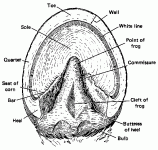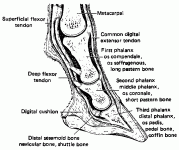♘امیرحسین♞
♘ مدیریت انجمن اسب ایران ♞
The modern horse would have little value other than for its possible breeding potential without healthy feet. Nevertheless, the foot has been the most neglected part of the horse since its early domestication. Close confinement, exaggerated gaits produced by intensive training, and poor conformation as a result of man's selective breeding for other purposes, have all compounded this problem. We hope that this discussion will help horsemen understand hoof functions and will provide standard names for parts that have been called by many different names in the past.
Topography of the Hoof
This description of the anatomy of the foot entails the hoof and all of the structures within it, with some reference to certain related structures. The hoof itself is nothing more than cornified epidermis , similar in makeup to man's fingernail, and contains no nerves or blood vessels but relies upon the corium , another inner layer just interior to the white line, to provide the circulation and sensitivity necessary to maintain a healthy foot. Since the hoof itself is not sensitive, we must understand its relationship to the inner structures in order to comprehend any lameness related to the hoof. The nomenclature (set of names) of the external parts of the hoof is divided into the following areas ( Figure 1 ):
Topography of the Hoof
This description of the anatomy of the foot entails the hoof and all of the structures within it, with some reference to certain related structures. The hoof itself is nothing more than cornified epidermis , similar in makeup to man's fingernail, and contains no nerves or blood vessels but relies upon the corium , another inner layer just interior to the white line, to provide the circulation and sensitivity necessary to maintain a healthy foot. Since the hoof itself is not sensitive, we must understand its relationship to the inner structures in order to comprehend any lameness related to the hoof. The nomenclature (set of names) of the external parts of the hoof is divided into the following areas ( Figure 1 ):


